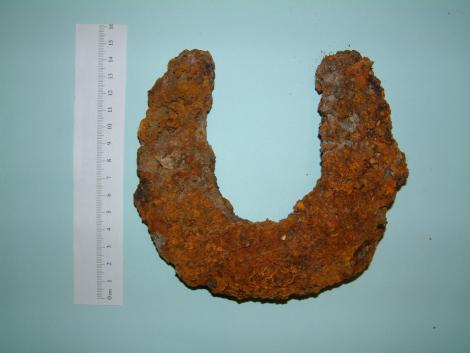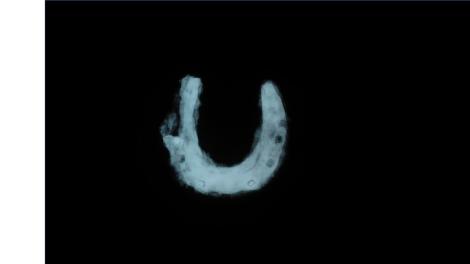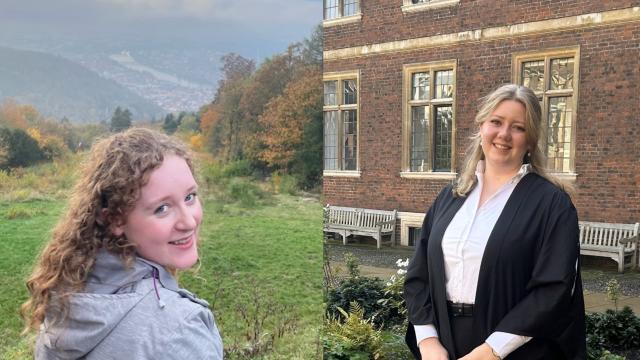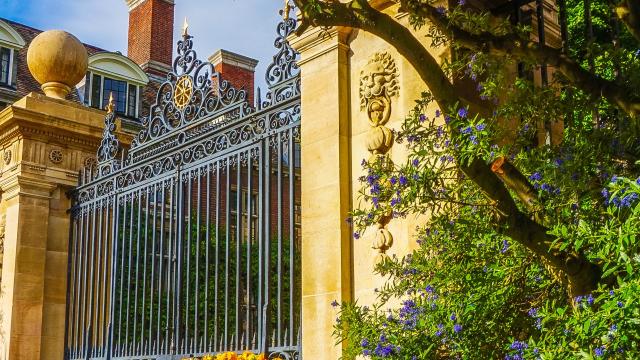Horseshoe by an unknown blacksmith
Iron
Created around the late 16th or early 17th century
Acquired by St Catharine’s 2017
The following article by Dr Philippa Moore (TWI Ltd) and alumna Eleanor Clapp (née Baines, 1996, Natural Sciences) was written for the 2019 edition of the St Catharine’s Magazine:
In 2017 when building work was being undertaken in the college, an old corroded horseshoe was discovered by Professor Anthony Davenport (1995) in the spoil from one of the trenches dug in Main Court, very close to the Hobson’s building. Knowing the connection of the building with Thomas Hobson, he wondered if this horseshoe could be contemporary with this famous figure from Cambridge history.
Hobson (1544–1621) was responsible for arranging the delivery of mail between London and Cambridge, up and down the Old North Road (now the A10). He operated a lucrative livery stable behind the George Inn, which was located in the vicinity of the current gates of the College. When his horses were not needed to deliver mail, he rented them to students and academic staff of the University. He soon realised that most people wanted to hire his fastest horses, which would mean that his best livestock would be overworked, while his steeds of a lower quality would not get hired at all. He became famous for his ‘Hobson’s Choice’ – any customer had a choice when hiring one of his horses; they could either hire the next horse in the line or not hire one at all. Or put more simply, Take It or Leave It! Could the horseshoe found so close to the location of Hobson’s stables belong to one of his horses?
The design of horseshoes has changed subtly over the centuries, and the arrangement of the nail holes and general shape of the iron shoe could help date the age of a horseshoe. But the one found at St Catharine’s was so corroded that the shape and nail holes could not be discerned without using an X-ray image. It was after discussing his find with College alumna, Eleanor Clapp (née Baines, 1996, NatSci) that Professor Davenport was advised to seek the help of local technology – engineering company TWI Ltd, where Eleanor’s twin sister Dr Philippa Moore works as a materials and integrity engineer.
TWI carries out consultancy, testing and inspection for a range of industries in areas relating to materials joining technology. As part of TWI’s work in forensic engineering investigations, it has experience of X-raying components damaged by fire, or corroded by service conditions subsea, for example, so TWI was well placed to inspect the corroded horseshoe. Non-destructive testing technician Connor Brookfield at TWI’s Test House carried out the X-ray of the fragile and corroded horseshoe.
The X-ray image revealed the shape of the iron horseshoe inside the corroded skin: it clearly shows the arrangement of at least six nail holes, with the lowest two possibly still containing square headed nails. It is flat, with no calkins visible at the ends (calkins are the bent over ends of a horseshoe, more common in modern horseshoes). This horseshoe design shows a slightly asymmetrical shape and a rounded arch. There is no toe clip at the bottom (a modern feature, invented in the mid nineteenth century), nor any fullered groove running around the outer edge (fullering is very unusual on horseshoes before the mid seventeenth century). From the early part of the seventeenth century there was a trend for horseshoes to spread inwards at the heel to create a keyhole type inner profile. However, the College’s shoe doesn’t have that profile, so could it be earlier in date?
The number and spacing of the nail holes is another clue. Earlier horseshoes tend to have fewer nail holes; late medieval shoes often have between six and eight. However, with all handcrafted items, there was significant variation in style across the country. In fact it was his horse’s shoes that almost gave away Charles II when he was fleeing after the battle of Worcester in 1651. Having arrived in Lyme Regis it was clear that the shoes of his horses needed attending to. A blacksmith was called in, but halfway through his work he suddenly turned to the disguised Charles II and said, “What manner of man are you whose horse has been shod in three different counties and one of them Worcester?”
So could a horse from Hobson’s stable have worn this shoe? Although we will never be absolutely certain and there were other stables nearby, the X-ray pictures give tantalizing hints that it certainly could come from a late sixteenth century or early seventeenth century horse, which would fit with Thomas Hobson’s lifetime. It is a definite possibility!





